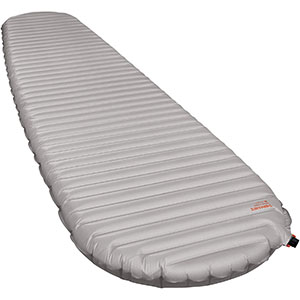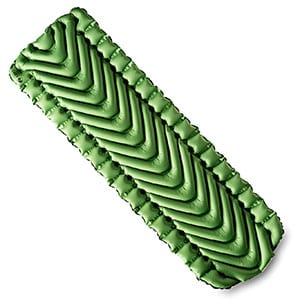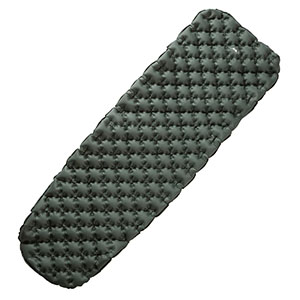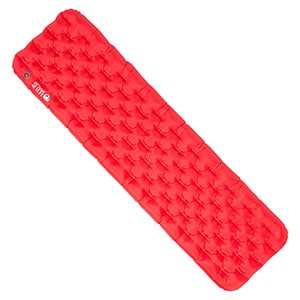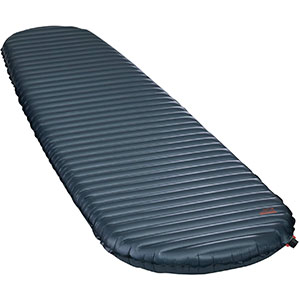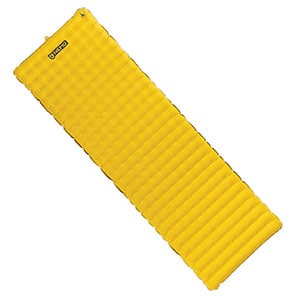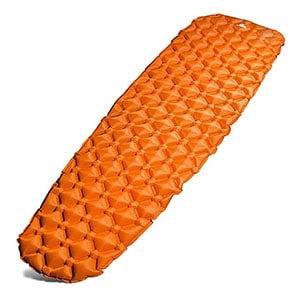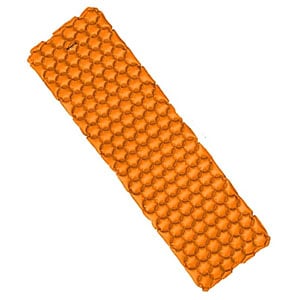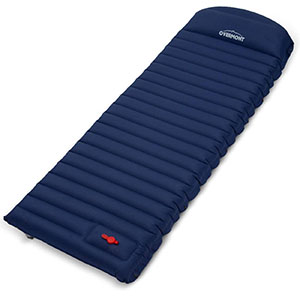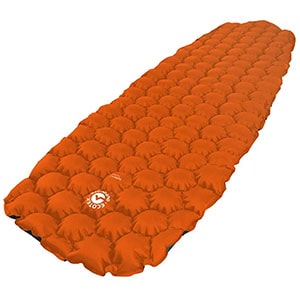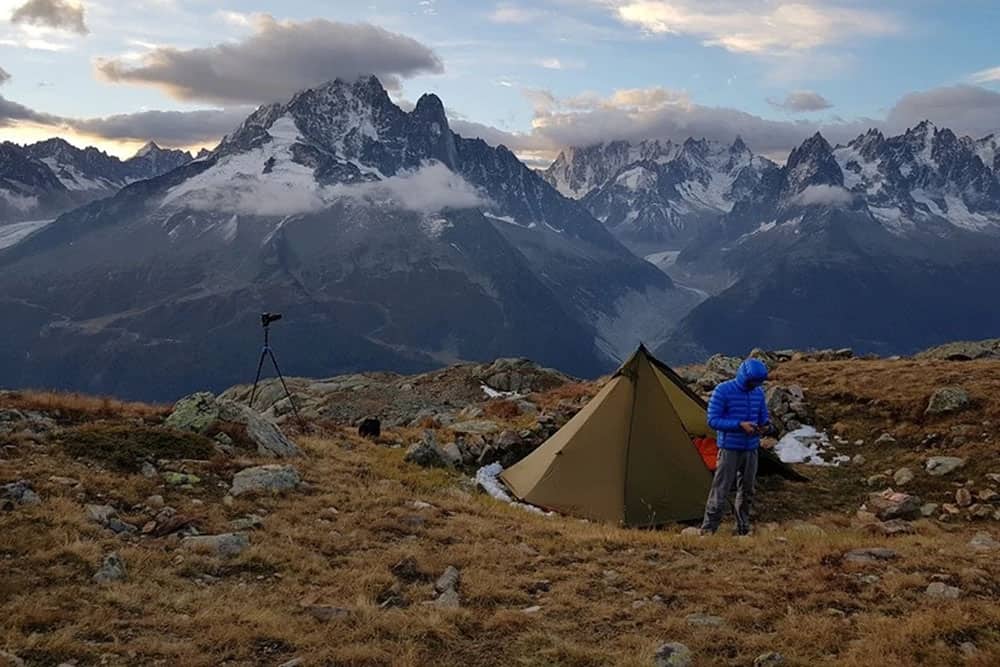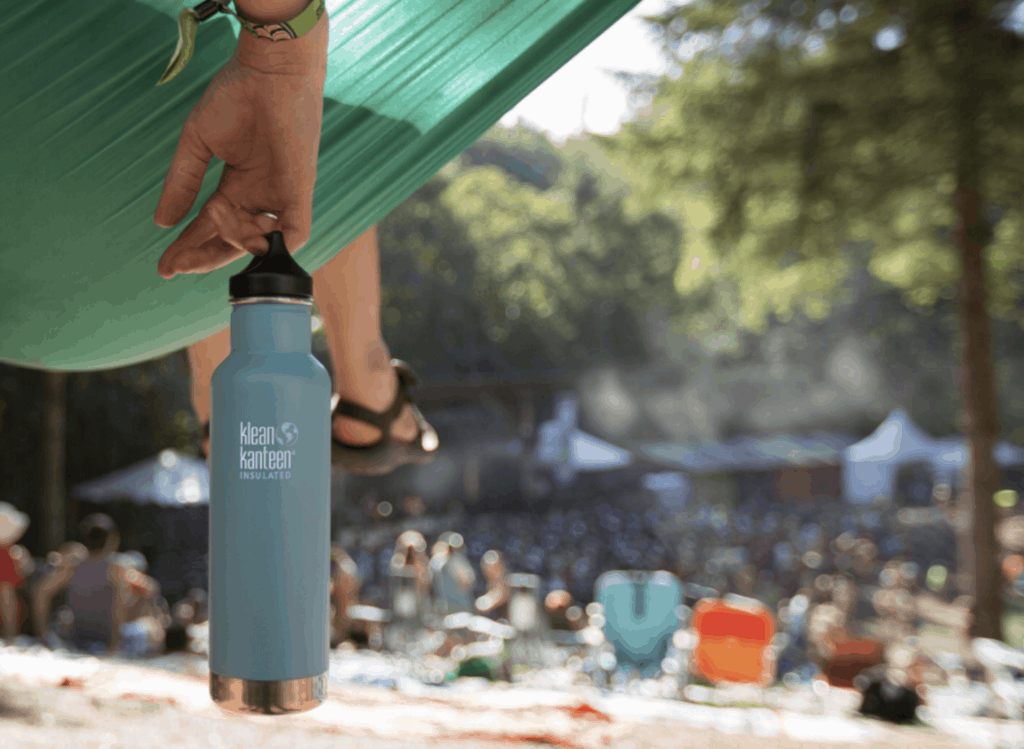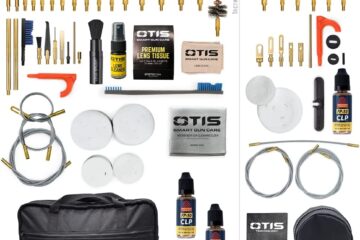A backpacking sleeping pad will help you get the restful sleep you need to stay alert and energized on the trail.
Today’s best sleeping pads for backpacking are light, durable, reliable, and warm. Many collapse down to almost nothing so they can be easily stowed in your backpack.
With so many backpacking sleeping pads on the market today it can be a challenge to find one that fits your needs to a T. So we’ve done the homework for you and compiled this list of the 10 best backpacking sleeping pads.
1. Therm-a-Rest NeoAir XTherm Ultralight
The people at Cascade Designs (owners of Therm-a-Rest) invented the self-inflating sleeping pad nearly 50 years ago. Since then they’ve never stopped learning and never stopped improving their product line. The NeoAir XTherm Ultralight is, in our opinion, the best sleeping pad they have ever made and the best backpacking sleeping pad on the market today. It’s incredibly light, blows up in under two minutes, has an R-value of 5.7 and is as tough as any other inflatable pad out there.
The mummy design reduces the amount of material involved which helps keep the weight down. And at 2.5 inches thick, it’s deep and firm enough to handle any size camper. You will pay more for the XTherm. But if you are a dedicated 4-season backpacker it will quickly become your best friend.
2. Klymit Static V Sleeping Pad
The Klymit Static V Sleeping Pad has a non-traditional profile, punctuated by its numerous square and chevron-shaped air chambers. But while it might look like a gimmick it’s anything but. The Static V is incredibly comfortable, inflates quickly, deflates just a quick and easy, and weighs a scant 1.3 pounds. The exterior shell is crafted from tough 75D polyester that will stand up to rocks and tree roots alike. And the Static V is long enough to accommodate tall hikers with ease.
That unusual look we mentioned serves the important purpose of ensuring that the air stays under you where it belongs, and doesn’t migrate to the edges while you bottom out. When you’re ready to break camp the Static V compresses into an 8 x 3 inch sack that can be slipped into your pack or slung from the outside.
3. Wellax Ultralight Air Sleeping Pad
The Wellax Ultralight Air Sleeping Pad may be the best value on the market. It’s fashioned from durable ripstop nylon, weighs less than the Static V we just looked at, inflates and deflates in a jiffy and does a great job keeping that warm, insulating air between you and the ground. The Wellax Ultralight is also a bit wider than some of its competitors, which gives you room to move around in your sleep without winding up on the bare tent floor.
The Ultralight features separate inflation/deflation valves, compresses down to 10 x 3 inches when deflated, and comes with its own durable stuff sack. With an R-value of 2.1 it’s going to be a little out of its league in the winter time. But for all but the most extreme weather it’s a rock-solid choice.
4. Big Agnes Insulated AXL Air
The Big Agnes Insulated AXL Air sleeping pad is an outstanding cool weather sleeping pad that’s tough and thick and designed to keep the air under you no matter what position you sleep in. The AXL Air tips the scale at under a pound, has an R-value of 3 and comes with a pump sack so you don’t get lightheaded blowing the thing up.
The Big Agnes AXL Air provides a discrete layer of insulation that traps body heat and redirects it back up at you. This tends to amplify the warmth generated by the pad, making the R-3 rating seem more like R-5 or 6. It doesn’t deflate as quickly as some other inflatables, but unless you’re on the clock that shouldn’t be an issue.
5. Therm-a-Rest Neoair Uberlite Sleeping Pad
Therm-a-rest makes a curtain call with this outstanding NeoAir Uberlite Sleeping Pad. This is a great 3-season pad with a 2.3 R-value that weighs just a hair more than 1/2 pound. When properly inflated it’s thick and warm and very comfortable on any terrain. When completely deflated it slips into the included stuff sack and can be slung or slipping into your pack.
The NeoAir is a quiet pad. None of that squeaking and creaking. There’s also an inflation bag to save your lungs and one of the best warranties in the industry. If there is a downside it’s that the design is such that it has a way of slipping out from under you if you move a lot while you sleep. But since you shouldn’t be using this in sub-zero weather it’s not such a big deal.
6. Nemo Tensor Ultralight Sleeping Pad
The Nemo Tensor Ultralight is durable, lightweight, comfortable and available as either a traditional rectangular or mummy. It has an R-value of 3.5, which means it could serve as a 4-season pad, depending on the quality of the bag you laid on it. At 15 oz it’s light enough for anyone to carry. And at 3 inches thick it will keep those bumps and lumps from digging into your back all night.
The Tensor Ultralight comes with an inflation sack to spare your lungs after a day of hiking. And it is warrantied for life against defects in material and workmanship. The large rectangular version does not compress as small as some other inflatable sleeping pads. But beyond that it’s hard to find fault with this pad.
7. Outdoorsman Lab Sleeping Pad for Camping
If you’re like a lot of us the thought of dropping $100 or even $200 on a sleeping pad doesn’t bring a smile to your face. Fortunately, you don’t have to spend that kind of money to get a great backpacking sleeping pad. The Outdoorsman Lab Sleeping Pad for Camping is a lightweight, durable, comfortable and affordable alternative to expensive pads.
The ultra durable ripstop nylon shell is fire resistant, the pad inflates in a hurry, support is excellent from border to border, and the pad collapses down to almost nothing. Sure, it doesn’t have the lifetime warranty of some more other pads, and the stuff sack might not last for years. But for the most part, this is an incredible 3-season value.
8. Powerlix Sleeping Pad
The Powerlix Sleeping Pad is the type of all-around backpacking value that makes you wonder why some other sleeping pads cost so much. The shell is rugged 75D waterproof nylon. The hexagonal air chambers ensure the air stays under you while you sleep and the pad weighs a modest 1.3 pounds.
The dual-action air value removes some of the hassle of inflating and deflating a pad. The inside layer of insulation reflects body heat back at you, the pad collapses to just 11 x 4 inches, and it makes a good pillow in its rolled up state.
9. Overmont Large Sleeping Pad
For those who want a bit of extra comfort on their backpacking adventure there’s the Overmont Large Sleeping Pad. This is great for backpacking trips when you maintain a base camp that you return to after day hikes. It also happens to be an excellent choice for 4-season camping, with its nearly 5 inches of loft and its R-value of 5.
As if all that wasn’t enough, the Overmont also inflates quickly, collapses down to a very manageable size and costs less than a pair of jeans. The only drawback (and you knew there had to be one) is that it weighs nearly 2 1/2 pounds.
10. Ecotek Outdoors Insulated Hybern8 Sleeping Pad
The last of our best backpacking sleeping pads is from Ecotek. Their Hybern8 4-Season Pad is an excellent 3-season bag that’s comfortable, rugged, easy to inflate and won’t break the bank. The shell is soft by durable 70D polyester. The hexagonal air pockets keep the loft under you. And with an R-value of 4.5 it’s ready for all but the most extreme weather.
The Hybern8 weighs just over a pound and a half and collapses down to 10 x 3 inches. It’s made in the US, comes with a nifty stuff sack with drawstring and boasts a lifetime warranty.
FAQs
What Is Backpacking Sleeping Pad?
A backpacking sleeping pad is related to the yoga mat, but designed and built for the harsher outdoor environment. Over the years the backpacking sleeping bag has evolved from a strictly closed-cell foam mat that you would roll up and attach to the outside of your pack, to an ultra-lightweight inflatable mat that tucks away neatly in your pack when deflated.
That’s not to say that closed-cell pads don’t still exist. They do. And lots of people use them because they’re affordable and durable and just fine for warm weather. The self-inflating sleeping pad also has plenty of fans. This type of pad occupies a middle ground between the closed cell mat and the ultralight inflatable.
Cascade Designs, parent company of Therm-a-Rest (1), pioneered the self-inflating pad back in the 1970s and for years held exclusive patents to produce them. Today, however, those patents are expired and numerous companies produce self-inflating backpacking sleeping pads.
What are the Benefits of a Backpacking Sleeping Pad?
Backpacking sleeping pads are comfortable – Discomfort is the constant companion of those who spend time in the backcountry or on the mountain. Backpacking is hard work and there are no comfy sofas waiting for you at the next tentsite. You’ll have to plunk your weary bones down onto stones and tree roots. A good backpacking sleeping pad can go a long way toward turning what would be a sleepless ordeal into a comfortable, restful night’s sleep.
Backpacking sleeping pads are warm – Outdoors, a cold front can move through in minutes sending the temperature plummeting (2). Even in the summer dramatic temperature drops are not unheard of. It’s important that you stay warm at night, and your sleeping pad has as much to do with that as your bag. The sleeping pad prevents body heat from being sucked into the cold ground. This layer of insulation enables the bag to do its job much more effectively.
Backpacking sleeping pads help you sleep better – If you have a good sleeping pad under you and a comfortable sleeping bag you have a surprisingly comfortable, rejuvenating sleep even thousands of feet up the mountainside or in the deep backcountry. That good night’s sleep is going to make your next day of hiking much easier.
Backpacking sleeping pads are easy to carry – You can’t carry a bed into the woods or up the mountain with you. But can easily carry an ultralight inflatable backpacking sleeping pad. Many of them weigh a half a pound or less. That’s light enough for anyone to take along with them. They also break down into tiny little stuff sacks that can either be slung from your pack or slipped inside the pack.
Backpacking sleeping pads enhance safety – As amazing as the outdoors can be, it is also fraught with dangers (3). It’s crucial that you be at your physical and mental best at all times to minimize the risk of injury or worse. Getting the restful sleep you need at the end of each day is the best way to ensure you stay sharp and safe.
Backpacking sleeping pads make for a more enjoyable time – The goal of a backpacking trip is to get away from the non-stop demands of contemporary life, enjoy the great outdoors and recharge your batteries. You can’t do that if you spend your nights tossing and turning inside the tent because you’re cold and uncomfortable. A good sleeping pad will allow you to wake up in the morning ready to enjoy the natural splendors that await.
Backpacking sleeping pads won’t die on you – So many things today, even things we bring into the woods with us like smartphones and tactical flashlights, rely on electricity. Once the batteries die they just become dead weight. No matter what is going on your backpacking sleeping pad will always be there, ready to serve you.
Backpacking sleeping pads will last for years – Some backpacking sleeping pads cost more than $100. That’s not cheap by any measure. But at the same time today’s backpacking sleeping pads are made to last. The sleeping pad you buy today could easily be serving you well 5 or 10 years from now.
What are the Different Types of Backpacking Sleeping Pads?
Most backpacking sleeping pads fall into one of the following three categories:
Inflatable – Most backpackers choose inflatable sleeping pads for a couple of very good reasons. First, they pack down nice and small (at least the best ones do) so they can be easily slung or stuffed into the backpack. And, second, because there is no filling, they are light. Sometimes remarkably light. If there is a downside to inflatables it’s that they are susceptible to punctures, and they tend to cost more than other pads.
Self-inflating – This is a kind of inflatable, but you don’t have to blow into the nozzle, it pulls in the air all by itself. With the self-inflatable you just unroll it, open the value and go do something else. When you return in a few minutes the pad is inflated and you just close the valve. They’re very convenient and reliable, and more comfortable than a closed cell foam pad. The downside is that, even deflated, they take up quite a bit of space. And they’re heavier than inflatables.
Closed cell foam – This type of pad is like a yoga mat (and indeed, some folks use their yoga mats as backpacking sleeping pads). Closed cell foam has a lot going for it (4), including the fact that it’s rugged, inexpensive, waterproof, and you don’t have to worry about it springing a leak. On the downside, it’s heavy, does not provide much by way of insulation, and it takes up a lot of space.
What Should I Look for in a Backpacking Sleeping Pad?
Weight – A lot of backpackers are ready to tell anyone who will listen how they carried a 100 pound pack through the woods for days on end. The truth is, if you weighed them, most of those 100 pound packs would be more like 20 pounds, and that’s alright. It’s still a lot to be carrying around. There are a lot of theories about how to calculate the right weight for a backpack (5). But the bottom line is that it’s imperative to reduce weight any way you can. Which is why so many backpackers choose ultralight inflatable sleeping pads.
R-value – The R-value (6) of a sleeping pad is not going to compete with what you put in your home (which can be as high as R-60 for an attic). But nonetheless, it’s important, especially if you are into cold weather backpacking. The higher the R-value the warmer the pad will be. If you are into summer backpacking only you shouldn’t need more than R-2. If you enjoy a bit of 3-season backpacking, look for an R-value of 2-4. And if you like pitching your tent in the snow, look for an R-value of 6+.
Noise level – This might seem like a strange thing to include, but some sleeping pads can be quite squeaky or crinkly, depending on who is describing it. But no matter how you characterize the noise some sleeping pads make, it can be an unpleasant distraction that can keep you, or others in the tent, awake at night.
Thickness – The job of the sleeping pad is twofold. First, it should provide a layer of cushioning between you and the often unforgiving ground. And second, it should prevent your body heat from being siphoned off by that same unforgiving ground on cold nights. Since that could lead to hypothermia (7). Your pad should be thick enough to do both.
Shape – Most pads are either rectangular or mummy-shaped. The rectangular sleeping pad allows you a bit of wiggle room during the night. While the mummy-shaped pad is typically lighter (less acreage), and contours to the shape of your mummy sleeping bag.
Can I Use One Sleeping Pad All Year Long?
Manufacturers routinely rate their pads the same way they rate their sleeping bags, with some rated for warm weather only and others rated for various degrees of cold. Most people, however, buy a single sleeping pad for their backpacking adventures and stick with it regardless of the weather.
That approach might work if the person only ventures out into the wild during the warm weather months. But if they aspire to enjoy the backcountry all year long they should have a sleeping pad that will bring something of value to the table when the air is so cold the water in the water bottles freezes solid.
Closed-cell foam pads are fine for summer backpacking, but won’t be much more than a hard, cold board under your bag in the winter time. Likewise, a state-of-the-art inflatable might keep you toasty warm when the mercury dips but be too much during the dog days of July and August. Before you put all your eggs in one (sleeping pad) basket, think about when you are likely to use it and get one that will cover you in any eventuality.
The Bottom Line
Today’s backpacking sleeping pads are light years ahead of anything your parents or grandparents had to work with. Today’s pads come in a dizzying array of sizes, styles, weights, and materials and are lighter, warmer and more durable than ever before.
When choosing a sleeping pad for backpacking make sure you choose one that will suit your needs. After all, you don’t want a poor choice in sleeping pads to be the difference between a great time and hypothermia, or a good night’s sleep and having a tree root digging into your side all night long.
Use the above information to determine exactly which backpacking sleeping pad is right for you.
